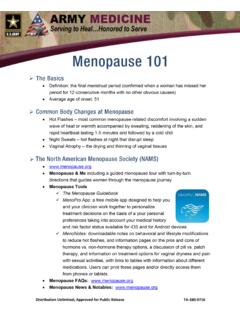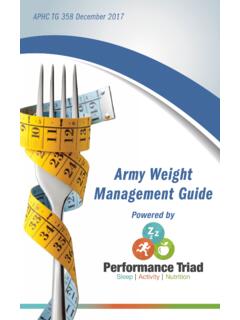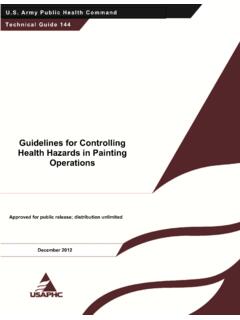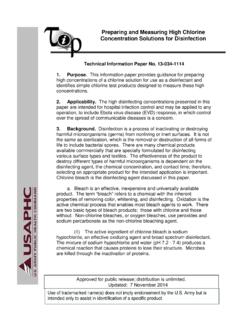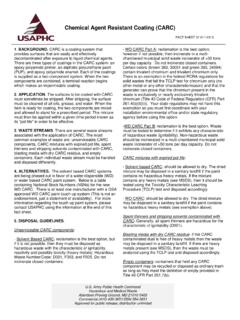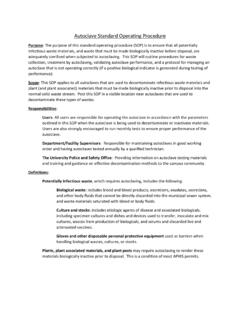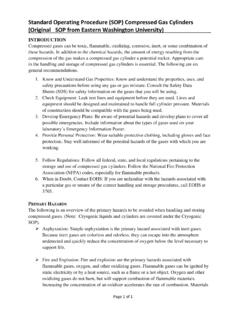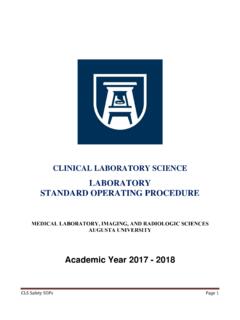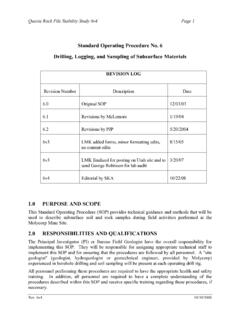Transcription of Writing and Managing a Standing Operating Procedure
1 Army Public Health Command (Provisional) Technical Guide 176 Writing and Managing a Standing Operating Procedure Approved for public release; distribution unlimited October 2010 Use of trademark name(s) does not imply endorsement by the Army but is intended only to assist in the identification of a specific product. USAPHC (Prov) TG No. 176 October 2010 TABLE OF CONTENTS Page 1. Purpose .. 1 2. Definition .. 1 3. Use .. 1 4. Developing and Publishing an SOP .. 2 5. Structuring an SOP .. 2 6. Filing an SOP .. 4 7. Maintaining a Historical Registry for Laboratory procedures .. 4 8. Revising an SOP .. 4 9.
2 Managing an SOP .. 5 USAPHC (Prov) TG No. 176 October 2010 1 Writing AND Managing A Standing Operating Procedure 1. Purpose. Technical Guide (TG) 176 is for the person(s) who must plan, write, revise, publish, or manage Standing Operating Procedure s (SOPs). The guidance is presented generically so that it can be used in any setting, such as administrative, industrial, laboratory, or field operations. This guide addresses both the format and content of administrative and technical SOPs. 2. Definition. An SOP is a clearly written set of instructions or methods detailing the procedures for carrying out a routine or recurring task or study. The use of SOPs describes both administrative and technical tasks.
3 3. Use. a. As a management tool, an SOP (1) Provides a foundation for training new employees by establishing operational procedures . (2) Serves as a continuity tool in cases where regular personnel are absent from an operation, enabling others to carry out the function. (3) Refreshes the memory of management and experienced employees regarding operational procedures within the organization. (4) Helps maintain quality control by providing detailed, step-by-step guidance to personnel who are required to carry out certain procedures . (5) Sets forth study methods that are adequate to ensure the quality and integrity of the data generated in the course of a study.
4 (6) Provides a documented, historical record of an organization's Operating procedures during a specific time period. USAPHC (Prov) TG No. 176 October 2010 2 b. As an administrative tool, an SOP can be used to (1) Decide where in an organization a Procedure should be carried out. (2) Decide what material and personnel resources are required. (3) Outline the manner in which procedures are to be carried out. 4. Developing and Publishing an SOP. a. Review your procedures and decide what needs to be explained in your SOP. Seek the input of personnel who have experience in these procedures . b. Gather information on the procedures from reference sources.
5 Contact other organizations performing similar functions to see if they have an SOP. If they do, request a copy to use as a guide or source of ideas. Often, such a document can be modified to serve your needs. c. Assemble all blank forms and other documents you will need to reference in the SOP. d. Assign the SOP a number and title for identification and reference purposes. e. Write a draft of the SOP, following the guidelines in paragraph 5. f. Review the draft SOP for technical adequacy and administrative accuracy. Make sure that the SOP conveys its message clearly, and that it answers the questions "who," "what," "when," "where," and "how." g. Submit the draft SOP for peer review and supervisory approval.
6 H. Incorporate approved changes into a final version. i. Sign and date the final version; include supervisors signature. On approval, distribute copies as appropriate, and post a copy in the SOP file for reference (see paragraph 6). 5. Structuring the SOP. a. Format. (1) Figure 1 shows the suggested format for an administrative SOP. USAPHC (Prov) TG No. 176 October 2010 3 (2) Figure 2 shows the suggested format for a technical SOP. b. Numbering the divisions and parts of an SOP. The divisions of an SOP (such as paragraphs, sections, and chapters) and certain parts (figures and tables) are numbered to help make referencing easier.
7 Table 1 explains the numbering scheme. c. Table of Contents. (1) If the SOP is over 10 paragraphs, include a table of contents. (2) In preparing the table of contents, list part, chapter, section, paragraph titles (if appropriate), and appendixes exactly as given in the body of the text and in the same order. d. Content. (1) Be clear, concise, and thorough when listing the step-by-step procedures . Remember that the person most dependent on your SOP is the employee who may have little or no experience with the Procedure in question. Technical phrases requiring special knowledge should be avoided except when no other word or phrase will convey the proper meaning.
8 To better appreciate what you must communicate, place yourself in the position of the employee that will be performing the tasks. Your greatest enemies are vagueness and imprecision. Your SOP will be of little use if no one can understand who is supposed to do what. (2) Include only those steps that are carried out by the employees in the immediate organization. When procedures include interactions with individuals outside of the organization, indicate this but do not specify the actual steps taken by the other persons. (3) Be comprehensive in terms of how to get the Procedure accomplished, but do not encompass irrelevant matters.. (4) Be positive in your presentation.
9 E. Appendices. Include appendices when it is necessary to finish additional or supplemental material (for example, reproduction of an agreement or a sample contract, list of references, sample plan for a maneuver or exercise). Appendices, if used, are placed at the end of the document. f. Glossary. Provide a glossary if the SOP contains more than 15 abbreviations or terms. USAPHC (Prov) TG No. 176 October 2010 4 g. Illustrations. Use illustrations only when they are essential, contribute to a clearer understanding of the subject matter, or substantially reduce the narrative portion of the SOP. 6. Filing the SOPs. When a number of SOPs have accumulated in a file, incorporate them into an SOP Manual.
10 A. Place the individual SOPs into a large binder, sorting the documents into chapters by subject. b. Arrange these chapters in a logical sequence (for example, all administrative procedures in one section and all laboratory procedures in another). c. Develop a table of contents, and place it in the front of the binder. d. Place the manual alongside other references such as Regulations and Pamphlets. 7. Maintaining a Historical Registry for Laboratory procedures . The supervisor must maintain a historical file of obsolete laboratory SOPS and revisions according to Title 21, Code of Federal Regulations (CFR), Section , Standard Operating procedures , and Title 40, CFR, Section , Standard Operating procedures .

